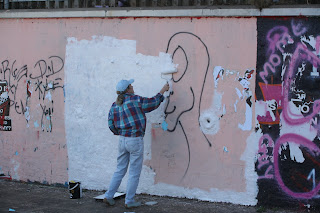
Cnr Jan Smuts and

Terry phoned David O’ Sullivan on 702’s Q and A, 2 Sept 2010:
T: I came across this thing and I thought what on earth is this thing….. I wanted to take a picture… .
D: So where abouts was it - in Parktown?
T: In Parktown…, Parktown West ....that sort of area…
D: This is the reason why the show is called Q and A, cause here anything goes - its real trivia this. It is a fabulous one - I enjoyed that one. Terry, I am going to find out where.. . who had the humour around poles and also….
T: Of course there is no blind people – nearby…
D: Ok. Terry lets see if we can find out where the poles .. uuu .. come from. In Parktown. Somebody with a mad sense of humour.
J: OK, well it is not necessarily a mad sense of humour – mm.. we also got an e mail from Ann in Springs, that came in a little bit to late for David to read. And Ann in Springs said:
“I know exactly what those pole interventions are. I am a second year visual arts student at Unisa and students did this as a witty art project. I know the polar bear didn’t last long. Many of the props were stolen very pretty quickly . For more information visit www.grafmom.blogspot.com”.
And I am looking at that, at that very very website, as we’re speaking; and joining us on the line is Celia de Villiers, who is a lecturer for the Department of Art History, Visual Arts and musicology at Unisa. Now Celia, are you going to tell us exactly what the street poles are?..for ?.. in Parktown?
C: Mmm.. Hello Jenny…thank you for the opportunity. I can’t tell you exactly what these street poles are about because it is an art project which is going to remain anonymous; because the site of urban, urban intervention is normally an anonymous thing that people do, and it is actually to create a forum for discussion, exactly what we are doing now.
And it opens new possibilities for people to have new opinions on certain issues. And mmm.. this pseudonym of grafmom, it is actually a student – and our students are of varying ages, we don’t have just young students at Unisa in the Art Department, but she is a mother already so the word grafmom means graffiti, graf for graffiti and a mom; and it stands for somebody who wants to fix or repair, and play the role of a mother in certain circumstances. So it is a kind of anonymous gift, that it is about a kind of communitas which has risen to relatedness. It relates to the interface between personal politics, contemporary culture and change. And also to give people a voice or a kind of identity or belonging, because she is actually working in the area that is her neighbourhood.
Her first intervention was to actually surround a pothole in the road with mmm… some bollards that should draw attention to the pothole and within a day that pothole was repaired and then there was even a comic done with Madam and Eve, about the pothole, within that very same week. So she’s created a forum for discussion about certain sort of political or personal and mm.. public political issues.
J: So what would be a political issue about the pole bear…a … you know about the polar bear ..
C: That is just a little bit of humour but also that there are some many poles that are actually standing around just doing nothing or being nothing or for no reason. Poles it become it mmm…. not necessary to be there but it is not being removed by mmm… the City Council.
J: Alright. So…very fascinating. Is she going to remain anonymous Celia?
C: Yes, yes.
J: Even after… even after all is revealed?
C: That’s right, this is the trend. We actually have an artist called Banksy in… in
J: So so how, how is it going to be revealed? Is there going to be a great big denuma or, or will it just peter out?
J: Alright, so we’re just going to have to wait and… and see. And we need to look around because obviously the’re going to be other comments.
C: That’s right.
The navigation of this type of project actually involves a lot of self control .. it involves a form of manipulation ..it is about adapting to the space… and the time and the timing should be crucial, because this grafmom actually went to the graffiti wall on the cnr of Jan Smuts Ave opposite… diagonally opposite Wits, and she made a whole big mural of gumboots, because Trevor Manuel said that this thing about the mine mmm.. spillage of water and the acid drainage is being exaggerated and we are not all going to rush out and buy gumboots. So she made a huge mural of gumboots.
J: Well it sounds fantastic and I want to say thank you very much indeed Celia de Villiers, just explaining the whole thing, aaa.. you know, to us, so look out not just for street poles in the Parktown area but, but it is in the area, but for other interventions as well.









